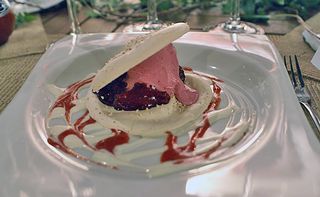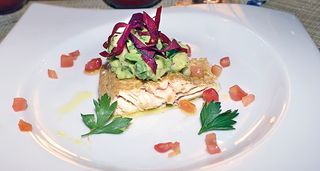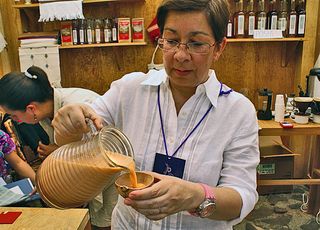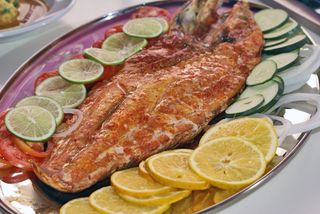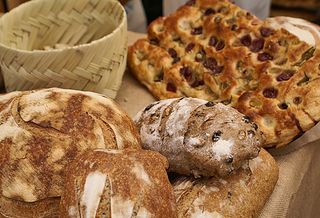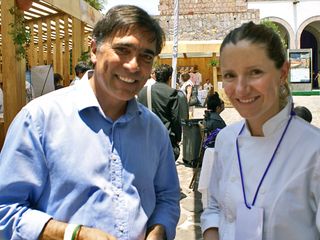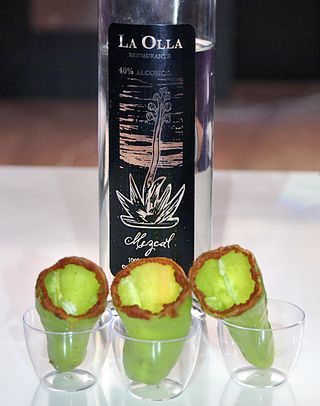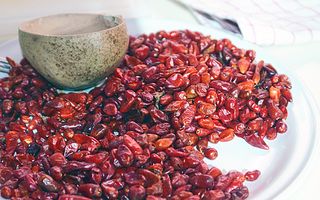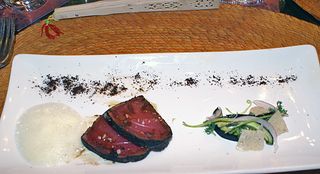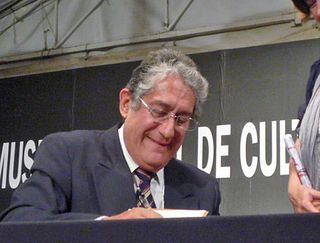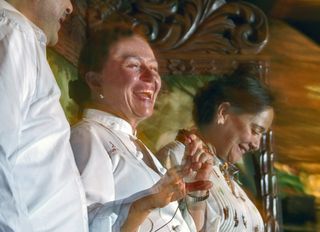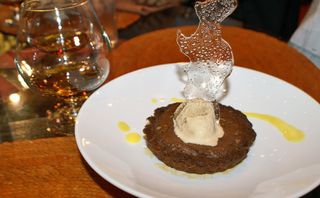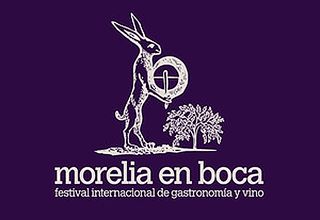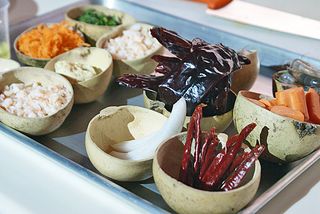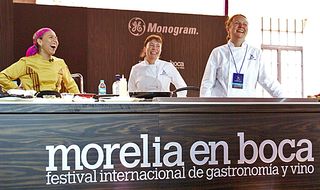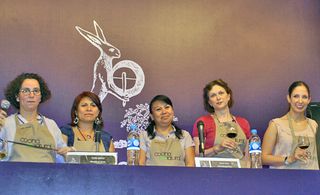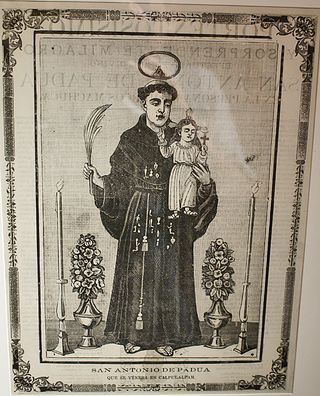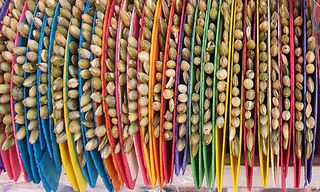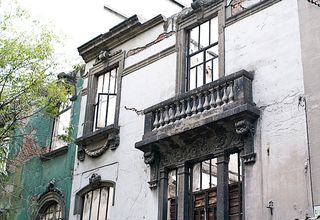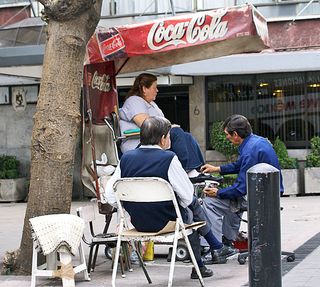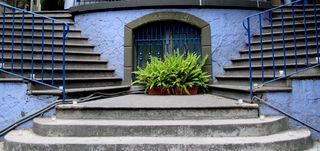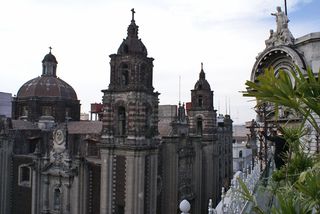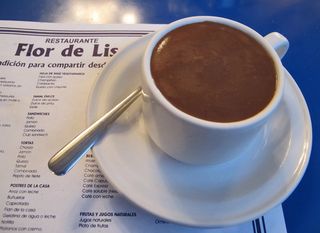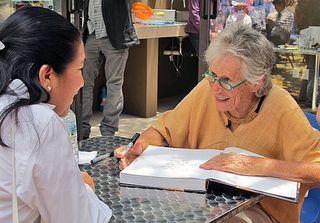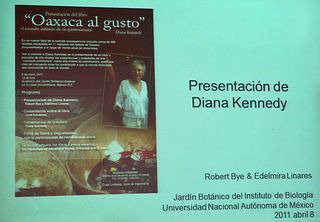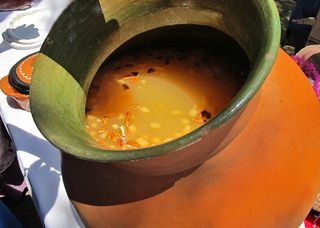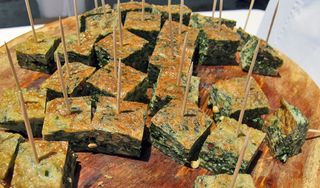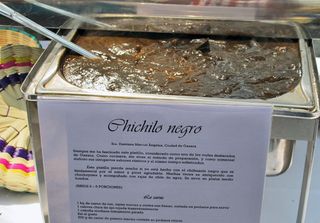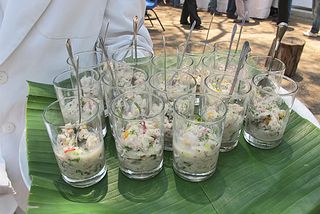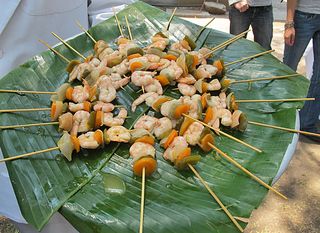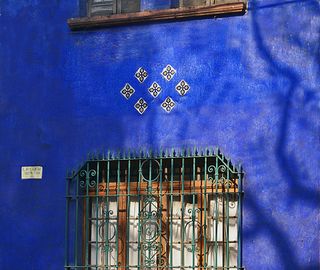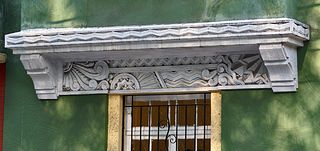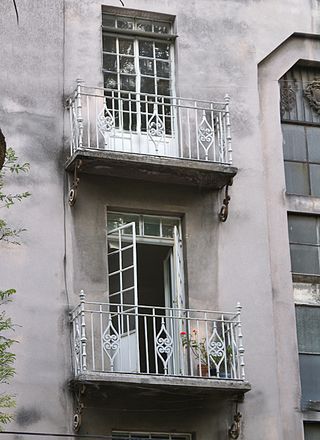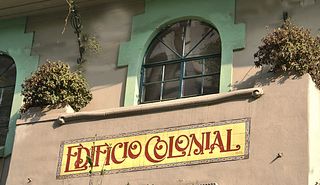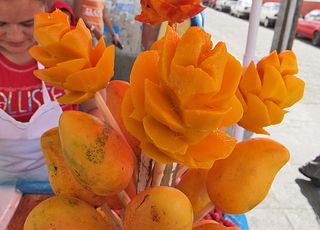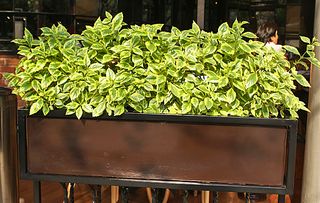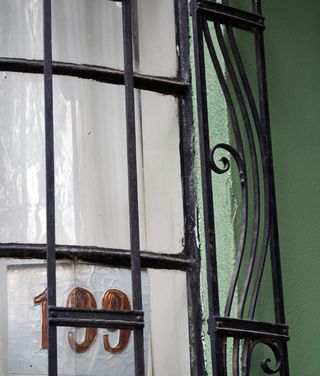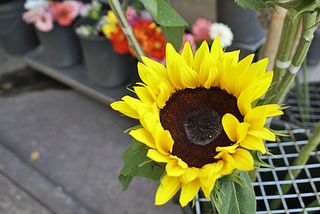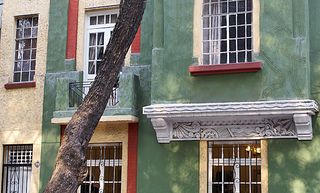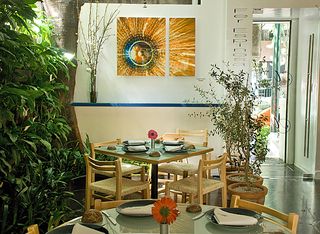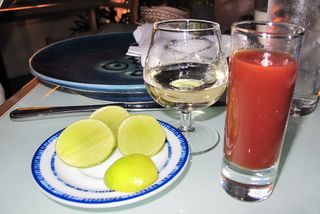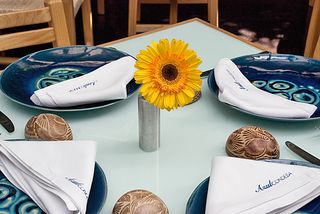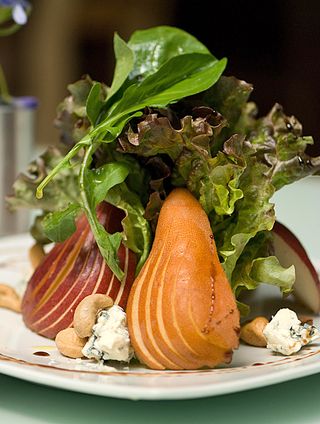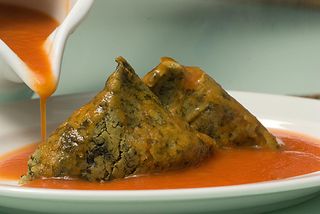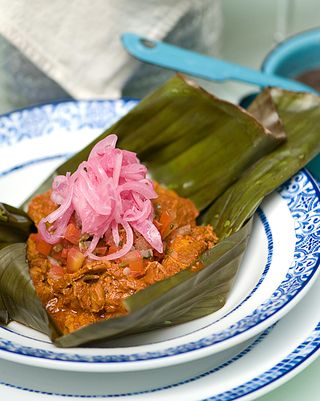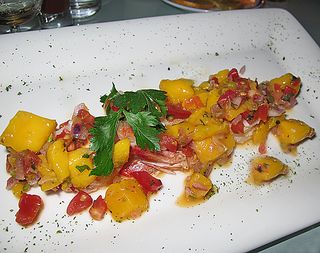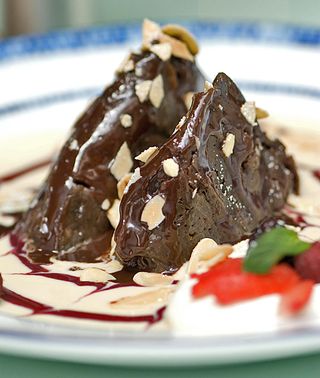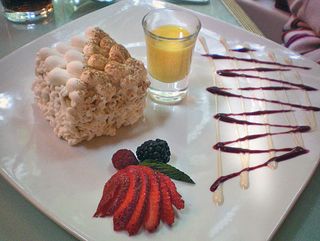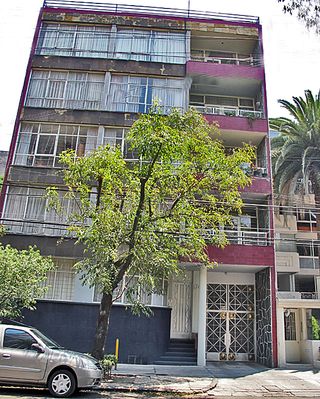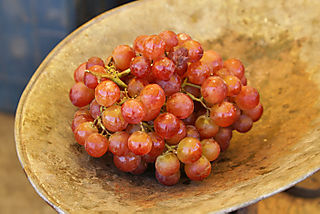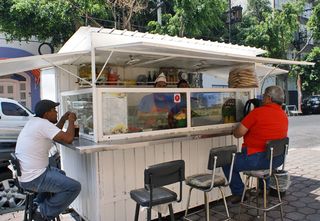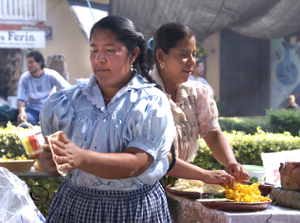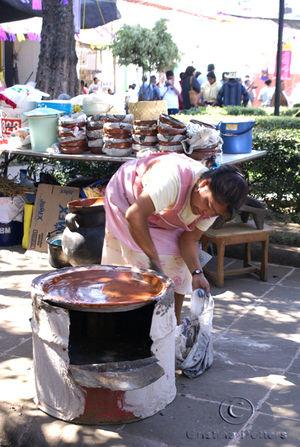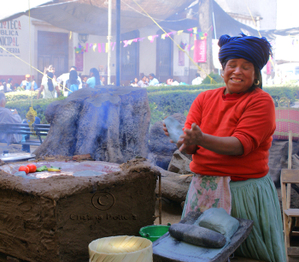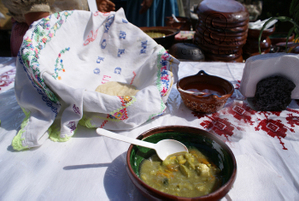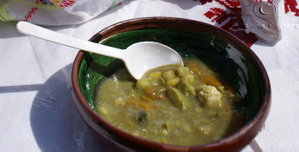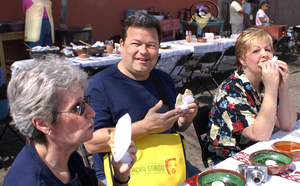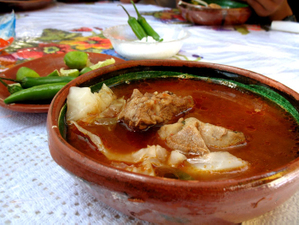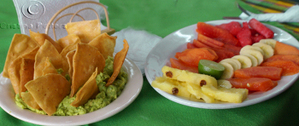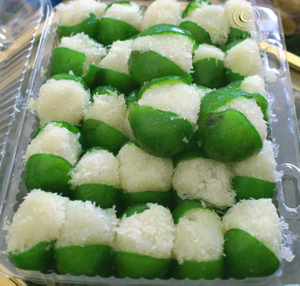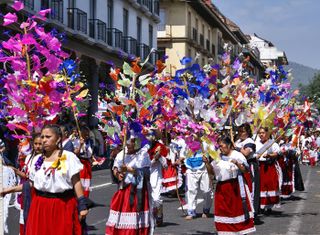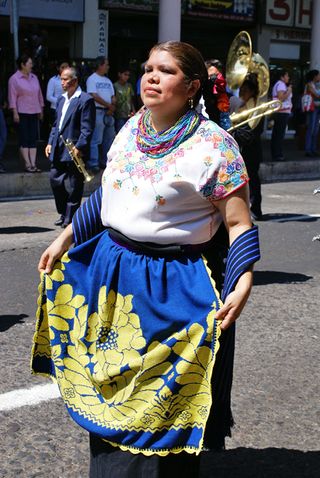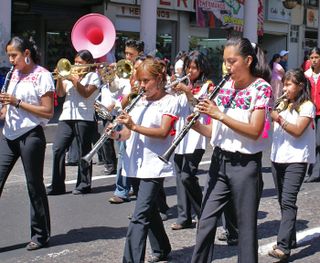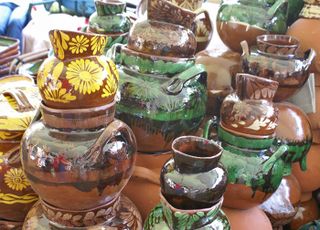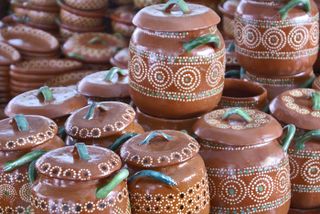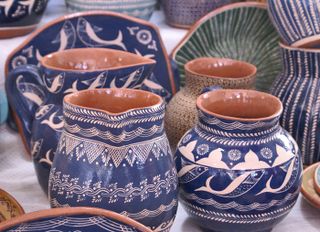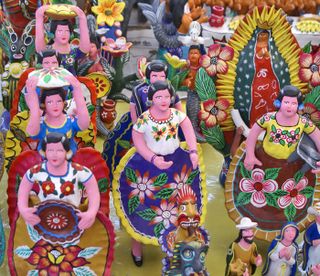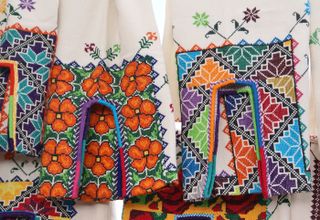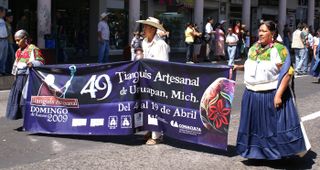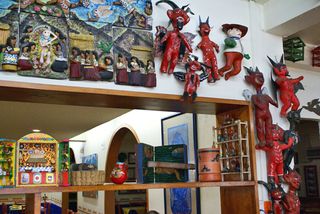
El Bajío's original restaurant is puro folclór (completely traditional and colorful) in its decor as well as its extraordinarily delicious food. The cardboard Judas (devil figures) are typically burned on Holy Saturday night, but these have survived to keep an eye on you as you dine.
At a recent book presentation at the UNAM Jardín Botánico (Botanical Garden at Mexico's national university), Mexico Cooks! renewed acquaintance with the deservedly celebrated Carmen Titita Ramírez Degollado, founder (with her husband) and owner of Mexico City's Restaurantes El Bajío. Titita, as she is known to family, friends, and faithful customers, graciously invited us to come for comida at whichever of the eight El Bajío restaurants we preferred, and we chose the founding site, in the far northern part of Mexico City called Azcapotzalco. We particularly wanted to see the birthplace of the legendary restaurant.
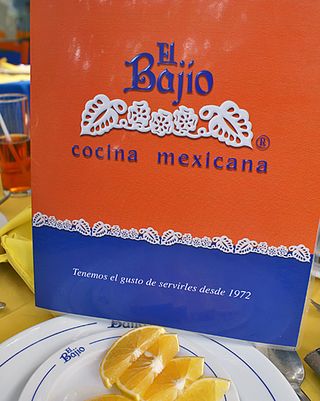
Founded by Titita's husband Raúl in 1972, the highly successful restaurant has now expanded to eight locations in various parts of Mexico's capital city.
Twenty-nine years ago, when Titita was left a widow with five children, she took over running the restaurant. Over the course of the years, it has become a temple dedicated to the preservation of Mexican recipes, particularly those from her Veracruz homeland. Her cooking skills, like those of all the best Mexican restaurant owners, were honed in her home kitchen, watching and learning from her mother and other female relatives and her childhood nanas (nannies). "Mexican food is not about fusion with other cooking styles. Mix Mexican food with Japanese, or Italian, and what do you get? Confusion! Traditional Mexican food is like traditional French or Italian cuisine: recipes and techniques are time-honored formulas carried intact into today's kitchens. My restaurant cooks might use a blender instead of a metate (volcanic grinding stone) to save time in the commercial kitchen, but the end result, the food on your plate, is the same as it was decades ago."
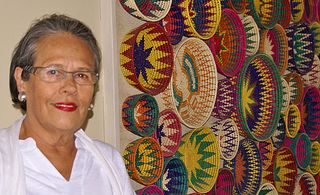
Titita next to the gorgeous wall of baskets that decorates the Colonia Polanco branch of El Bajío. After our several-hour multi-course meal at the original location, Titita took us to Polanco to see that site. "Yes, we'd love to go with you today–but," we begged her, "please, please, don't feed us anything else!"
Because we were Titita's guests, we barely looked at the El Bajío menu. Titita, a supremely generous hostess, graciously ordered a lengthy tasting menu for us, a selection of some of her clients' favorite items. The full menu is available at the restaurant's website.
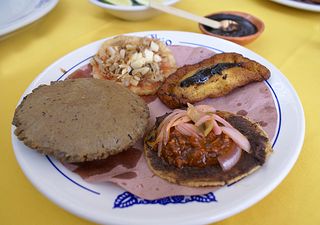
The first course brought to the table was antojitos de banqueta (little sidewalk whims), so called because these treats are normally eaten while you're standing at a street stand. Clockwise from nine o'clock on the plate, we ate a gordita de frijol inflada (puffed-up thick tortilla, the masa mixed with black beans, served with that tiny dish of smoky salsa de chipotle meco), a garnacha orizabeña (a small tortilla topped with Orizaba-style shredded beef, diced potato, and, in this case, red salsa), an empanada de plátano macho (the masa (dough) of the empanada is made of sweet, ripe plantain which is then filled with black beans and fried), and a panucho yucateco (a small tortilla covered with Yucatecan-style black beans, cochinita pibil, onion and chile habanero).
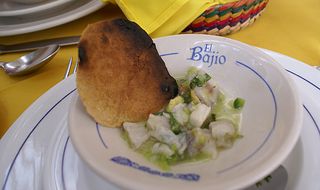
Next, each of us tried a tasting-menu size portion of cebiche verde de cazón (green ceviche made of dogfish, a kind of shark, marinated in citrus and chile).
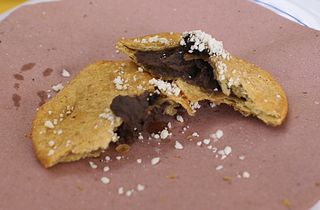
One tiny round empanada rellena con frijoles negros (a round empanada filled with black beans), dusted with Cotija cheese. The beans were delicious with the subtle anise flavor of dried avocado leaves.
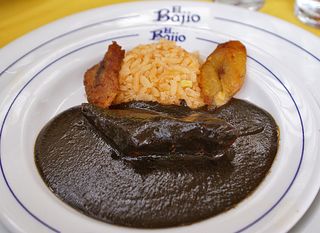
Arroz con mole de Xico (Mexican red rice with Xico-style mole), accompanied by a tiny serving of chicken breast and slices of plátanos machos fritos (fried ripe plantains).
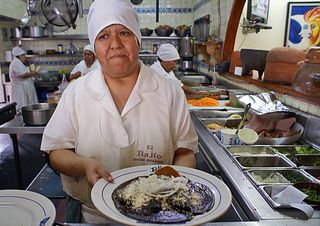
Mayora Sandra Olvera is in charge of making El Bajío's mole; she's holding a standard-size plate, ready to be served to a restaurant client. Doña Sandra has been in the kitchen at El Bajío for its entire 40 years. For more than 30 years, Mexico Cooks! has eaten mole everywhere in Mexico and this extraordinary mole de Xico is by far my favorite.

Two of the members of Los Tuxpeños, a group specializing in traditional music from Veracruz. They are often at El Bajío to enliven the guests' comida (main midafternoon meal of the day).
A short breather in between courses: I confess that I was ready to be disillusioned by El Bajío. Whether cracking open a much-ballyhooed best-selling book, planning to see an Oscar-winning movie, or tucking into a legendary restaurant's meal for the first time, I am often guilty of having the preconceived notion that, "It couldn't possibly be as good as the hype." Let me tell you that El Bajío is at least as good as its publicity. The atmosphere is lovely, the food is world class, and the service is excellent.
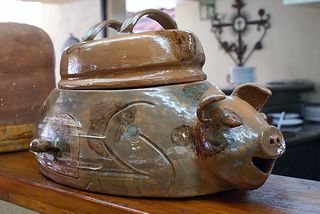
Titita told me that this little clay pig–although it's not so little, measuring more nearly a meter from snout to tail–hails from Toluca and is used to steam-heat tamales. The door in the side, once used for carbón (Mexico's charcoal), is now used for an alcohol burner.
Titita and her restaurants have participated in world-wide events and have won every prize conceivable, including the following:
- 1998 "The Amercian Academy of Hospitality Services" Five Star Diamond Award.
- Participated for 10 years in the culinary events of Festival Anual del Centro Histórico de la Ciudad de México.
- Consultant for various restaurantes in the United States and Europe.
- Active member of the Asociación Mexicana de Restaurantes (AMR).
- Member of the International Association of Professional Chefs (I.A.C.P.) of the USA.
- For three years, demonstrated Mexican cuisine at the Culinary Institute of America in Napa Valley, California.
- Represented Mexico in the USA-based television commercials for the campaign "Got Milk" in Los Angeles, California.
- Won recognition as "La Llave Empresarial 2006" granted by AMAIT y ABASTUR in México.
- Nominated by the New York Times as one of the two great matriarchs of Mexican cooking.
- Won the 2008 and 2009 restaurant business merit prize.
Titita assured me that the menu, the quality, and the prices are the same at all of the eight El Bajío locations, regardless of neighborhood and regardless of clientele.
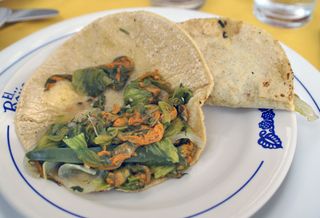
Quesadillas de flor de calabaza (quesadillas made with squash flowers, epazote, onion, garlic, and chile jalapeño). The deep, rich, complicated flavor of these quesadillas was pure Mexico.
Somehow we dived into two of the courses much too fast and the food escaped the Mexico Cooks! camera. One was a taco of delicious carnitas estilo Tacámbaro (Tacámbaro-style pork) that gave us a taste of our beloved Michoacán, the other, a tasting plate of pescado a la veracruzana (Veracruz-style fish, with tomatoes, onions, and olives), brought us back to Titita's birthplace on Mexico's east coast.
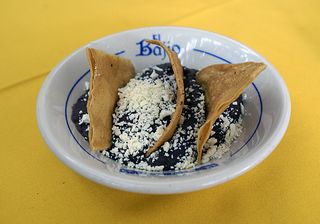
The last touch to a typical meal from the east coast of Mexico: a small dish of frijoles negros refritos (refried black beans), to eat with totopos (tortilla chips) or to roll into a small taco. One of these is plenty as the final toquecito salado (little salty touch) to a meal such as ours.
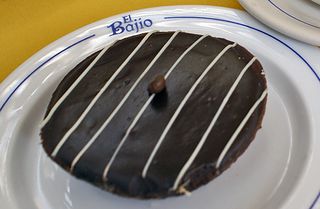
And then there was dessert! We shared two: first, a marvelous individual-size dark chocolate tart filled with cajeta (otherwise known as dulce de leche) and topped with a coffee bean, created by María Teresa Ramírez Degollado (Titita's daughter), her partner Joan Bagur Bagur and their staff at Artesanos del Dulce.

Next, the hands-down best capirotada I have ever eaten. If you've been around Mexico Cooks! for long, you know that I am a huge fan of this typically Lenten dessert–but wow, this one is stupendous for any time of year.
Titita also gave us a copy of her beautiful cookbook, Alquimias y Atmósferas del Sabor: Alta Gastronomía de doña Carmen Titita (Alchemy and Atmospheres of Flavor: Haute Cuisine of doña Carmen Titita), with superb photo illustrations by internationally known photographer Ignacio Urquiza, Editorial Tiempo Imaginario, México. First published in 2001, the book won the Gourmand World Cookbook Award in 2002. The second edition was published in 2009. As far as Mexico Cooks! knows, the book is presently available only in Spanish.
Alquimias y Atmósferas del Sabor is as exquisite in its presentation as in its recipes, several of which are offered on the menu at all of the El Bajío restaurants. Try Titita's recipe for empanadas de plátano macho; it's very simple and will make your household and your guests sigh with delight. Here is Mexico Cooks!' translation of Titita's recipe. Serve these empanadas with any Mexican main dish you choose and freshly prepared rice; they are marvelous with a rich mole served with chicken or pork.
+———-+———-+———-+———-+———-+———-+
Empanadas de Plátano Macho Rellenas con Frijoles Refritos
Plantain Dough Empanadas filled with Refried Beans
Ingredients
3 very ripe platános machos (plantains), skins on
Salt to taste
1 quart water
Enough vegetable oil to fry the empanadas, with a little extra to coat your hands while shaping them
Refried black beans
Special utensil
Tortilla press or rolling pin
The plantains are ready to use when their yellow skins have turned almost entirely black and are showing a bit of mold–just when you might think it is time to pitch them in the trash.
The day before you want to serve the empanadas, cook the plaintains without peeling them in the quart of boiling water. Allow them to cool overnight.
The next day, peel the plaintains and discard the peels. Mash the plantains to make a smooth paste that you will use as the empanada dough. Rub vegetable oil all over your hands and make 12 little balls of the plantain dough.
To flatten the dough, put each ball between two sheets of plastic (a cut-open freezer bag would work very well) and flatten into circles with either a rolling pin or the tortilla press.
In the middle of each plantain dough circle, put a tablespoonful of refried black beans. Fold each empanada in half, completely covering the beans with the plantain dough. Firmly press the edges together so that the beans cannot escape while the empanadas are cooking.
Heat the oil almost to the smoking point and fry the empanadas until they are a beautiful deep golden color. Drain on absorbent paper.
Arrange on a small platter, garnish with a flower or two, and serve.
Makes 12 empanadas as a side dish.
You will love these empanadas and your family will beg for them.
+———-+———-+———-+———-+———-+———-+
Click for the El Bajío location nearest you in Mexico City: Sucursales
When you go, please tell Titita that Cristina at Mexico Cooks! sent you, and give her a hug from me.
Looking for a tailored-to-your-interests specialized tour in Mexico? Click here: Tours.
